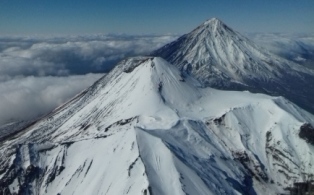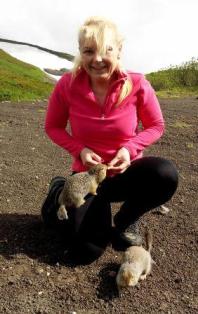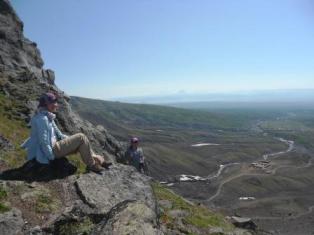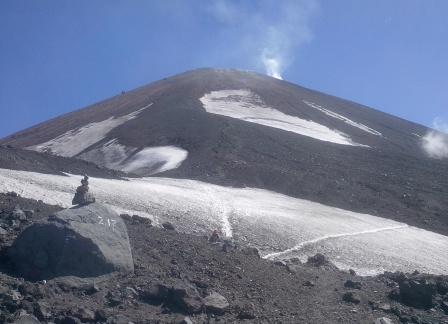Ascent of Avachinsky volcano in 2 days

- General information
- Detailed program
- Necessary equipment
- Tour cost
Short description
Route: Petropavlovsk-Kamchatsky - Camel Rock - Avachinsky volcano - Petropavlovsk-Kamchatsky.
Additional information:

Avachinsky volcano (2741 m) - (or Avachinskaya Sopka) is one of the most active and most visited volcanoes of Kamchatka. It is located 25 km NE of Petropavlovsk-Kamchatsky - Kamchatka's largest city, in southern Kamchatka. It is a stratovolcano that consists of a younger cone inside the rim of an older caldera and belongs to the Somma-Vesuvius type with the height of the somma 2317 m. The volcano contains a 4 km wide base and a summit crater 360 m wide and 250 m deep. The crater's appearance changed in width and depth from eruption to eruption.
It continues to experience frequent earthquakes, and many fumaroles exist near the summit. The temperature of gases emitted at fumaroles on the slope has been measured at over 150°C, and at the crater fumaroles – over 700°C.
Avachinsky volcano has erupted at least 18 times in recorded history, since 1737. The eruption of 15-16 June 1779 was witnessed by Captain Cook's expedition was one of the largest at the volcano. Ash fell on Cook's ships in Avacha bay. A large (VEI=4) explosive eruption occurred at Avachinsky in 1945, when about 0.25 km³ of magma was ejected. The most recent eruption in 1991 lasted from 13-30 January and was observed well from Petropavlovsk.
Koryaksky volcano (3456 m) - (or Koryakskaya Sopka) is a typical conical stratovolcano located 30 km NW of Petropavlovsk-Kamchatsky – the administrative center of Kamchatka peninsula. It lies on the "Pacific Fire Ring", at a point where the Pacific Plate is sliding underneath the Eurasian Plate at about 80 mm per year.
The volcano is considered one of the most beautiful in Kamchatka. It can be climbed by experienced in mountaineers equipped by crampons and ice axes. There are two glaciers on the eastern slope; 4.2 and 1 km in length. Koryaksky volcano is grooved by deep radial ravines. The slope of the lower cone is 15 – 20o rising to a maximum of 30-35o in the upper cone. The volcano has probably been active for tens of thousands of years. Geological records indicate that there have been three major eruptions in the last 10 000 years, at 5 500 BC, 1 950 BC and 1 550 BC. These three eruptions seem to have been mainly effusive, generating extensive lava flows. One more moderately explosive eruption occurred in 1926, after which the volcano lay dormant until 1956. The 1956 eruption was more explosive than the previous known eruptions, with VEI=3, and generated pyroclastic flows and lahars.
Kozelsky volcano (2190 m) is considered to be extinct. It is a part of the Avachinsky-Koryaksky volcano group and is located 25 kilometers westwards of the Pacific coast. Only two large Holocene eruptions of Kozelsky volcano are known, both of them took place in early Holocene.
There have been found grains of the rarest and hardest mineral - black diamond (carbonado). This unique formation may be met in some areas of the world and in small proportion. There is a summer camp for mountain skiers training on the volcano slope at the altitude of 850 m asl.

Flora and fauna at the foot of Avachinsky volcano there are numerous holes of blackheaded marmots. One of a main species of mountain tundra are arctic ground squirrels – the beloved animals by all Kamchatka people. These small animals will greet you at the altitude of 600 to 1500 m.
Attention! All the animal species and plants at the foot of Avachinsky volcano are under protection! It is allowed to collect plants for personal botanical collections only with permission of the Direction of Nalychevo Nature Park!
Hints: try to plan the ascent to a sunny and serene day. Pay some time to studying weather sites before booking the tour!
Day 1
10:00 am: Meeting with the guide.

10:15 am: Transfer by all-terrain bus to the foot of Avachinsky volcano to the altitude of 860 m asl.
The basic part of the road lies along the riverbed of a dry river. It will take us 2 – 2,5 hours to get to the destination, depending on the road conditions.
12:30 pm: Arrival at the destination – a volcanic plateau between Avachinsky (2741 m.) and Koryaksky (3456 m.) volcanoes. Accommodation in huts for 4 – 10 people or in double tents on the territory of a base camp.
01:00 pm: Safety instructions. Walking excursion to the mountain "Camel" (1200 m asl.).
Lunch on route. The whole excursion takes you 3 – 4 hours

The natural monument - "Mountain Camel" located on the mountain pass between Avachinsky and Koryaksky volcanoes – is a moderate rocky massif with two sharp summits. The mountain was formed during the eruption of both volcanoes, as great amount of incandescent lava was extruded out of a fissure as a result of the Earth crust movement.
06:00 pm: Return to the base camp. Dinner. Instructions for the next day. Overnight stay in camp.
Day 2
06:00 am: Breakfast.
07:00 am: Ascent to the volcano crater.

People get to the summit along the western slope by the ascending path. The ascent takes approximately 6 – 8 hours depending of the tourists’ physical fitness.
If you suddenly feel bad or find it impossible for you to continue, the guide’s assistant will accompany you back to the base camp, where you may relax and drink some tee while waiting for the rest of the group to return.
Lunch on the volcano slope at the altitude of 2000 m.
Climbing the young cinder cone.
The steepness of the slope at the top is almost 30°.
The weather permitting – walk around the crater.
03:00 pm: Descent to the base camp.
It takes usually 3 – 4 hours to get back to the foot of the volcano.
06:00 – 07:00 pm: Return to the camp. Dinner.
08:00 pm: Drive back to the town.
- backpack (no less than 45 l.);
- comfortable trekking shoes / trekking boots with high tops;
- gaiters;
- sleeping bag;
- warm hat;
- gloves;
- windproof (fleece) jacket;
- waterproof jacket or raincoat;
- sunglasses, sunburnt treatment cream;
- trekking poles (if necessary);
- head torch.
Tourists carry all their personal equipment and foodstuff themselves.
The services of the porters are paid additionally if necessary.



